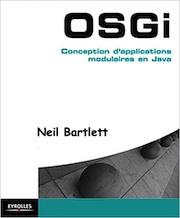
|
FreeComputerBooks.com
Links to Free Computer, Mathematics, Technical Books all over the World
|
|
- Title OSGi In Practice
- Author(s) Neil Bartlett
- Publisher: Everything Computer Science and GitHub; eBook (Final Draft)
- ebook PDF (313 pages, 2.5 MB)
- Language: English
- ISBN-10: N/A
- ISBN-13: N/A
- Share This:

|
What is OSGi? Simply put, The OSGi (Open Service Gateway Initiative) is a standardized technology that allows developers to create the highly modular Java applications that are required for enterprise development. OSGi lets you install, start, stop, update, or uninstall components without taking down your entire system. The interest in OSGibased applications has exploded since major vendors like Sun, Spring, Oracle, BEA, and IBM have gotten behind the standard.
This book is a comprehensive guide to OSGi with two primary goals. First, it provides a clear introduction to OSGi concepts with examples that are relevant both for architects and developers. Then, it explores numerous practical scenarios and techniques, answering questions like: How much of OSGi do you actually need? How do you embed OSGi inside other containers? What are the best practices for moving legacy systems to OSGi?
About the Authors- Neil Bartlett is a software developer, consultant and trainer specialising in Java, OSGi, Eclipse and Scala.

- OSGi In Practice (Neil Bartlett)
- The Mirror Site (1) - PDF
- Modular Java Creating Flexible Applications with OSGi and Spring (Craig Walls)
-
 Building Reactive Microservices in Java (Clement Escoffier)
Building Reactive Microservices in Java (Clement Escoffier)
This book is for developers and architects interested in developing microservices and distributed applications. It does not explain the basics of distributed systems, but instead focuses on the reactive benefits to build efficient microservice systems.
-
 Microservices for Java Developers: Frameworks and Containers
Microservices for Java Developers: Frameworks and Containers
In this hands-on, example-driven guide, Java developers and architects will learn how to navigate popular application frameworks, such as Dropwizard and Spring Boot, and how to deploy and manage microservices at scale with Linux containers.
-
 Microservices Best Practices for Java (Michael Hofmann, et al)
Microservices Best Practices for Java (Michael Hofmann, et al)
This book covers Microservices best practices for Java. It focuses on creating cloud native applications using the latest version of Server and other Open Source Frameworks in the Microservices ecosystem to highlight Microservices best practices for Java.
-
 Developing Reactive Microservices: Implementation in Java
Developing Reactive Microservices: Implementation in Java
In this book, author walks Java developers through the creation of a complete reactive microservices-based system. The result? A system that's easier to deploy, manage, and scale than a typical Java EE-based infrastructure.
-
 Modern Java EE Design Patterns: Building Scalable Architecture
Modern Java EE Design Patterns: Building Scalable Architecture
This book will help you understand the challenges of starting a greenfield development vs tearing apart an existing brownfield application into services, and examine your business domain to see if microservices would be a good fit.
-
 Microservices for Java Developers: Frameworks and Containers
Microservices for Java Developers: Frameworks and Containers
In this hands-on, example-driven guide, Java developers and architects will learn how to navigate popular application frameworks, such as Dropwizard and Spring Boot, and how to deploy and manage microservices at scale with Linux containers.
-
 Building Reactive Microservices in Java (Clement Escoffier)
Building Reactive Microservices in Java (Clement Escoffier)
This book is for developers and architects interested in developing microservices and distributed applications. It does not explain the basics of distributed systems, but instead focuses on the reactive benefits to build efficient microservice systems.
-
 Software Architecture with Spring 5.0 (Rene Enriquez, et al)
Software Architecture with Spring 5.0 (Rene Enriquez, et al)
This book explains in detail how to choose the right architecture and apply best practices during your software development cycle to avoid technical debt and support every business requirement, from scratch or is being refactored to support new demands.
-
 Real-World Maintainable Java Software (Abraham Marin-Perez)
Real-World Maintainable Java Software (Abraham Marin-Perez)
With this practical book, you'll learn 10 easy-to-follow guidelines for delivering Java software that’s easy to maintain and adapt. These guidelines have been derived from analyzing hundreds of real-world systems.





